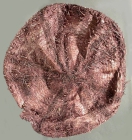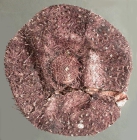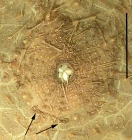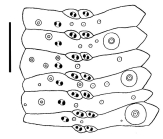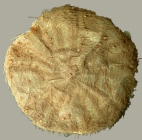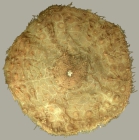Echinoidea taxon details
Hygrosoma hoplacantha (Thomson, 1877)
513346 (urn:lsid:marinespecies.org:taxname:513346)
accepted
Species
Hygrosoma aethiopicum Döderlein, 1905 · unaccepted (subjective junior synonym)
Hygrosoma hoplacanthum (Thomson, 1877) · unaccepted (incorrect declination of species name)
Phormosoma hoplacantha Thomson, 1877 · unaccepted (transferred to Hygrosoma)
marine, brackish, fresh, terrestrial
recent only
(of Phormosoma hoplacantha Thomson, 1877) Thomson, C.W. (1877). The voyage of the "Challenger." The Atlantic; a preliminary account of the general results of the exploring voyage of H.M.S. "Challenger" during the year 1873 and the early part of the year 1876, Volume 1 xxix+424 pp. (Macmillan and Co.: London). , available online at https://www.biodiversitylibrary.org/page/11731289
page(s): 148-149; fig. 35 (p. 148) [details]
page(s): 148-149; fig. 35 (p. 148) [details]
Kroh, A.; Mooi, R. (2025). World Echinoidea Database. Hygrosoma hoplacantha (Thomson, 1877). Accessed at: https://www.marinespecies.org/Echinoidea/aphia.php?p=taxdetails&id=513346 on 2025-05-15
Date
action
by
original description
(of Hygrosoma aethiopicum Döderlein, 1905) Döderlein, L. (1905). Über Seeigel der deutschen Tiefsee-Expedition. <em>Zoologischer Anzeiger.</em> 28/18: 621-624., available online at http://www.biodiversitylibrary.org/page/9903339#page/631/mode/1up
page(s): 621 [details]
original description (of Phormosoma hoplacantha Thomson, 1877) Thomson, C.W. (1877). The voyage of the "Challenger." The Atlantic; a preliminary account of the general results of the exploring voyage of H.M.S. "Challenger" during the year 1873 and the early part of the year 1876, Volume 1 xxix+424 pp. (Macmillan and Co.: London). , available online at https://www.biodiversitylibrary.org/page/11731289
page(s): 148-149; fig. 35 (p. 148) [details]
context source (Deepsea) Intergovernmental Oceanographic Commission (IOC) of UNESCO. The Ocean Biogeographic Information System (OBIS), available online at http://www.iobis.org/ [details]
basis of record Mortensen, T. (1935). A Monograph of the Echinoidea. II. Bothriocidaroida, Melonechinoida, Lepidocentroida, and Stirodonta, 647 pp., C. A. Reitzel & Oxford University Press, Copenhagen & London.
page(s): 208-215 [details]
redescription Anderson, O. F. (2016). A review of New Zealand and southeast Australian echinothurioids (Echinodermata: Echinothurioida)—excluding the subfamily Echinothuriinae—with a description of a new species of <em>Tromikosoma</em>. <em>Zootaxa.</em> 4092(4): 451., available online at https://doi.org/10.11646/zootaxa.4092.4.1
page(s): 472-475; figs 18-21 [details] Available for editors
page(s): 621 [details]
original description (of Phormosoma hoplacantha Thomson, 1877) Thomson, C.W. (1877). The voyage of the "Challenger." The Atlantic; a preliminary account of the general results of the exploring voyage of H.M.S. "Challenger" during the year 1873 and the early part of the year 1876, Volume 1 xxix+424 pp. (Macmillan and Co.: London). , available online at https://www.biodiversitylibrary.org/page/11731289
page(s): 148-149; fig. 35 (p. 148) [details]
context source (Deepsea) Intergovernmental Oceanographic Commission (IOC) of UNESCO. The Ocean Biogeographic Information System (OBIS), available online at http://www.iobis.org/ [details]
basis of record Mortensen, T. (1935). A Monograph of the Echinoidea. II. Bothriocidaroida, Melonechinoida, Lepidocentroida, and Stirodonta, 647 pp., C. A. Reitzel & Oxford University Press, Copenhagen & London.
page(s): 208-215 [details]
redescription Anderson, O. F. (2016). A review of New Zealand and southeast Australian echinothurioids (Echinodermata: Echinothurioida)—excluding the subfamily Echinothuriinae—with a description of a new species of <em>Tromikosoma</em>. <em>Zootaxa.</em> 4092(4): 451., available online at https://doi.org/10.11646/zootaxa.4092.4.1
page(s): 472-475; figs 18-21 [details] Available for editors
 Present
Present  Inaccurate
Inaccurate  Introduced: alien
Introduced: alien  Containing type locality
Containing type locality
Syntype (of Hygrosoma aethiopicum Döderlein, 1905) MCZ 867, geounit Africa Coasts [details]
From editor or global species database
Spelling Although the ending of the species name may seem feminine and thus incorrect, it is in fact a compound noun formed from "hople" [Greek: thorn] and "akantha" [a Greek nymph]. According to ICZN regulation species names based on compound nouns are not adujusted to the gender of the generic name (Art. 31.2.1.). [details]
| Language | Name | |
|---|---|---|
| Japanese | エンマノフクロウニ | [details] |

